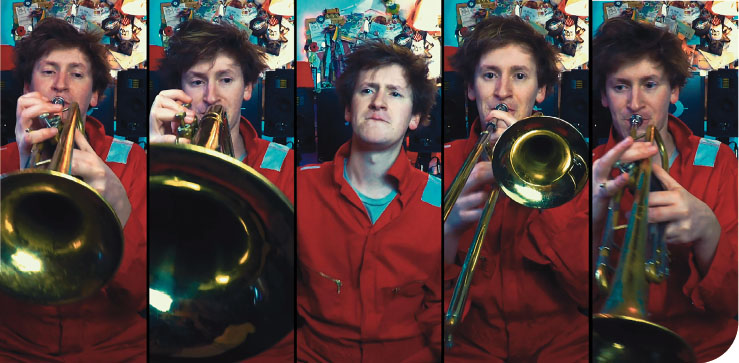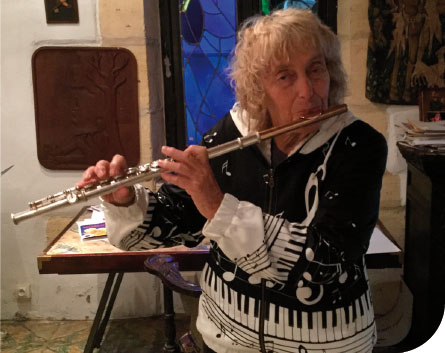
Fifty thousand is not, insists Seb Skelly, a particularly large amount when it comes to YouTube channel subscribers. But that is what the trumpeter, composer and arranger has surpassed for his videos of entertaining arrangements and original compositions for brass ensemble and big band.
He has steadily transformed what started out as a recreational activity a decade ago into a regular focus, alongside gigging as a trumpeter, of his professional work. He now aims to post a new clip every Wednesday: some are played by his big band, the Stretchy Legs Big Band, others by Skelly himself, multi-track recording the parts in his home studio.
‘I've got a fake trombone and tuba sound because I don't actually play trombone and tuba – I stumbled on a way to make my flugelhorn and little soprano trombone sound kind of like the real thing. The recordings aren't the sort of thing I'd put on a CD or a music streaming service, but they work quite well with the videos and get people interested in buying the sheet music.’

Branching out
Making his arrangements available to purchase has been the main commercial benefit, with YouTube acting as the shop window. Almost all the advertising money generated by his videos goes to YouTube's owners Google and to the copyright holders of the music he arranges.
‘I get a very tiny percentage. Most of the money comes from sheet music sales, so I have to make songs that people are going to want to play with their ensembles. But because I like to make the arrangements a bit more creative and interesting and add my own flair, they have to be something I enjoy as well. I look at the charts a lot, but a lot of classic songs as well as I have a lot of older, hobbyist ensembles who play a lot of my arrangements. Classic rock is actually quite popular.’
Skelly's YouTube channel allows him to interact with subscribers, so he often asks for requests and posts polls to assess where people's current interests might lie. He is also just starting to branch out into offering video tutorials around the work he does, too, adding a more obviously educational flavour to his output while still catering to his subscriber base.
Skelly's involvement with recording and arranging grew out of an all-consuming interest in music at his school, Dame Alice Owens in Hertfordshire. ‘I spent a lot of time playing in ensembles: there was a brass ensemble, a brass quintet, wind band, orchestra… It was definitely music that I did at school – I didn't get involved with anything other than music.’
He even returned as a member of staff after finishing a degree in music technology at Surrey University, working for a while as a part-time music technician before he left to focus on his professional music career.


Overcoming hurdles
Selling arrangements, of course, means confronting copyright issues – not necessarily a complicated process, he says. He recommends the website sheetmusicplus.com, owned by the Hal Leonard publishing house. ‘They have the licences to thousands of songs; they have a scheme where you can upload your own arrangements to their website, and they give you a small commission.’
Another potential obstacle to the budding YouTuber is keeping motivated in the early stages. Here, too, Skelly says not to lose heart. ‘At first, it can seem like no one's watching your videos. You see all these people with millions of subscribers, but it starts very slowly. Putting stuff out there and not expecting anything to come back is probably the way to do it. Doing it because you want to do it, not because you want to have the following.’
It is not even necessary to be a natural social media user, confident about self-promotion. Skelly himself admits he has a personal dislike of it. ‘I begrudgingly force myself to post online. Building up mailing lists is something I've started doing, and actually having more of a direct contact that way.’ So, while he does have pages on Instagram and Facebook, he says he does not post there frequently.
He does, however, use Patreon, the platform which allows followers to fund an individual's work through regular donations. As such it is less public facing, but still allows interaction with a public. ‘They are a bit more of a focused community as well: I talk to them a lot more than I do to the commenters. I take suggestions from them and have conversations and answer questions.’
That said, his YouTube subscribers are now a recognisable community, and a generally friendly one, judging by their reactions to his videos. ‘I actually don't get too many critical comments, which is quite nice and quite rare for YouTube. So hopefully I'm doing something right!
‘Once you start getting dislikes and negative comments, I think you've made it on YouTube – you've reached outside your bubble of fans. But it's good to read the comments and work out what resonates with people. It is a social platform, at the end of the day, so it's all about communication.’
Seb Skelly is speaking at the Music Teacher Summit on 17 June. Book now at www.musicteachersummit.com








